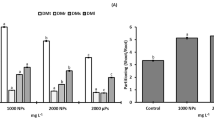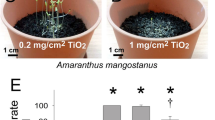Abstract
The effects of nano-size titanium dioxide (N-TiO2) on the germination of tomato (Lycopersicum esculentum L.), onion (Allium cepa L.), and radish (Raphanus sativus L.) seeds were assessed in laboratory and greenhouse trials. Seeds were germinated in Petri dishes in a laboratory and in peat:perlite (1:1, v/v) in a greenhouse containing four concentrations of N-TiO2 (0, 100, 200, and 400 mg L-1). N-TiO2 at 100 and 200 mg L-1 had the most positive effect on germination. In the laboratory, the highest germination percentage of tomato and onion was observed at 100 mg L-1 (100 and 30%, respectively), and in radish, 100% germination was obtained with 400 mg L-1. In the greenhouse, seedlings were tallest after exposure to 400 and 200 mg L-1 for tomato and onion, respectively, and 400 and 100 mg L-1 for radish. N-TiO2 may serve as a seed-priming agent for horticultural crops.
Similar content being viewed by others
References
Alimohammadi M, Xu Y, Wang DY, Biris AS, Khodakovskaya MV. 2001. Physiological responses induced in tomato plants by a two-component nanostructural system composed of carbon nanotubes conjugated with quantum dots and its in vivo multimodal detection. Nanotechnology 22: 295–101
Cañas JE, Long M, Nations S, Vadan R, Dai L, Luo M, Ambikapathi R, Olszyk E. 2008. Effects of functionalized and nonfunctionalized single-walled carbon nanotubes on root elongation of select crop species. Environ. Chem. Toxicol. 27: 1922–1931
Castiglione MR, Cremonini R. 2009. Nanoparticles and higher plants. Caryologia 62: 161–165
Castiglione MR, Giorgetti L, Geri C, Cremonini R. 2010. The effects of N-TiO2 on seed germination, development and mitosis of root tip cells of Vicia narbonensis and Zea mays L. J. Nanoparticle Res. 13: 2443–2449
Clément L, Hurel C, Marmier N. 2013. Toxicity of TiO2 nanoparticles to cladocerans, algae, rotifers and plants-effects of size and crystalline structure. Chemosphere 90: 1083–1090
El-Temsah YS, Joner EJ. 2012. Impact of Fe and Ag nanoparticles on seed germination and differences in bioavailability during exposure in aqueous suspension and soil. Environ. Toxicol. 27: 42–49
Fan RM, Huang YC, Grusak MA, Huang CP, Sherrier DJ. 2014. Effects of nano-TiO2 on the agronomically-relevant Rhizobium-legume symbiosis. Sci. Total Env. 466–467: 503–512
Feizi H, Amirmoradi S, Abdollahi F, Jahedi Pour S. 2013a. Comparative effects of nanosized and bulk titanium dioxide concentrations on medicinal plant Salvia officinalis L. Ann. Rev. Res. Biol. 3: 814–824
Feizi H, Kamali M, Jafari L, Moghaddam PR. 2013b. Phytotoxicity and stimulatory impacts of nanosized and bulk titanium dioxide on fennel (Foeniculum vulgare Mill). Chemosphere 91: 506–511
Feizi H, Rezvani Moghaddam P, Shahtahmassebi N, Fotovat A. 2012. Impact of bulk and nanosized titanium dioxide (TiO2) on wheat seed germination and seedling growth. Biol. Trace Elem. Res. 146: 101–106
Geisler-Lee J, Brooks M, Gerfen JR, Wang Q, Fotis C, Sparer A, Ma X-M, Berg RH, Geisler M. 2014. Reproductive toxicity and life history study of silver nanoparticle effect, uptake and transport in Arabidopsis thaliana. Nano materials 4: 301–318
Gimenez LJ, Martínez-Sanchez F, Moreno A. 1990. Titanium in plant nutrition. III. Effect of Ti (IV) on yield of Capsicum anuum L. In: Proceedings of III National Symposium on Mineral Nutrition of Plants, SPIC-UIB, pp 123–128
Haghighi M, Heidarian S, Teixeira da Silva JA. 2012. The effect of titanium amendment in N-withholding nutrient solution on physiological and photosynthesis attributes and micro-nutrient uptake of tomato. Biol. Trace Elem. Res. 150: 381–390
Hartman HT, Kester D, Davies FT, Geneve RL. 2002. Plant Propagation: Principles and Practices. Pearson Education, 7th ed, 880 p
Khot LR, Sankaran S, Mari Maja J, Ehsani R, Schuster EW. 2012. Applications of nano materials in agricultural production and crop protection: A review. Crop Prot. 35: 64–70
Kuzel S, Hruby M, Cigler P, Tlustos O, Van PN. 2003. Mechanism of physiological effects of titanium leaf sprays on plants growth on soil. Biol. Trace Elem. Res. 91: 1–11
Lee CW, Mahendra S, Zodrow K, Li D, Tsai Y, Braam J, Alvarez PJJ. 2010. Developmental phytotoxicity of metal oxide nanoparticles to Arabidopsis thaliana. Environ. Toxicol. Chem. 29: 669–
Lin BS, Diao SQ, Li CH, Fang LJ, Qiao SC, Yu M. 2004. Effects of TMS (nanostructured silicon dioxide) on growth of Changbai larch seedlings. J. Forest. Res. 15: 138–140
Lin DH, Xing BS. 2007. Phytotoxicity of nanoparticles: inhibition of seed germination and root growth. Environ. Pollut. 150: 243–250
Lu CM, Zhang CY, Wen JQ, Wu GR, Tao MX. 2002. Research of the effect of nanometer materials on germination and growth enhancement of Glycine max and its mechanism. Soybean Sci. 21: 168–172
Maleki N, Safavi A, Doroodmand MM. 2011. Fabrication of a room temperature hydrogen sensor based on thin film of single-walled carbon nanotubes doped with palladium nanoparticles. J. Exp. Nanosci. 22: 1–14
Mishra V, Mishra RK, Dikshit A, Pandey AC. 2014. Interactions of nanoparticles with plants: an emerging prospective in the agriculture industry. In P Ahmad, S Rasool, Eds, Emerging Technologies and Management of Crop Stress Tolerance: Biological Techniques (Vol 1), Elsevier Inc., San Diego, pp 159–180
Mohammadi M, Doroodmand MM, Hoseini A, Habibagahi M. 2011. The effects of single walled carbon nanotubes (SWCNTs) on proliferation and apoptosis of human peripheral blood mononuclear cells (PBMCs). Clin. Biochem. 44: 290–295
Sarmiento C, Daood H, Pais I, Biacs PA. 1995. Effect of titanium ascorbate on lipoxygenase pathway of tomato and red pepper seedling. J. Plant Nutr. 18: 1291–1299
Seeger EM, Baun A, Kastner M, Trapp S. 2009. Insignificant acute toxicity of TiO2 nano particles to willow trees. J. Soils Sediment. 9: 46–53
Sheykhbaglou R, Sedghi M, Tajbakhsh Shishevan M, Seyed Sharifi R. 2010. Effects of nano-iron oxide particles on agronomic traits of soybean. Not. Sci. Biol. 2: 112–113
Soleimani A, Doroodmand M, Sabaghi S. 2012. Comparative investigation on the correction factors of hydrogen permeability on CNTs-mixed matrix membrane. Int. J. Nano Dimensions 4: 217–221
Su AH, Lin KF, Zhang W, Xu SY, Yang SS. Zhang M, Zhang LY. 2009. Effect of nano-TiO2 on the germination and growth of rape seed. J. Agro-Environ. Sci. 9: 2–19
Yang F, Hong FS, You WJ, Liu C, Gao FQ, Wu C, Yang P. 2006. Influences of nano-anatase TiO2 on the nitrogen metabolism of growing spinach. Biol. Trace. Elem. Res. 110: 179–190
Yang L, Watts DJ. 2005. Particle surface characteristics may play an important role in phytotoxicity of alumina nanoparticles. Toxicol. Lett. 158: 122–132
Zheng L, Hong F, Lu S, Liu C. 2005. Effect of nano-TiO2 on strength of naturally aged seeds and growth of spinach. Biol. Trace Elem. Res. 105: 839–841
Author information
Authors and Affiliations
Corresponding author
Rights and permissions
About this article
Cite this article
Haghighi, M., Teixeira da Silva, J.A. The effect of N-TiO2 on tomato, onion, and radish seed germination. J. Crop Sci. Biotechnol. 17, 221–227 (2014). https://doi.org/10.1007/s12892-014-0056-7
Received:
Revised:
Accepted:
Published:
Issue Date:
DOI: https://doi.org/10.1007/s12892-014-0056-7




